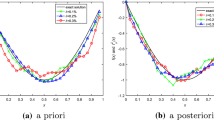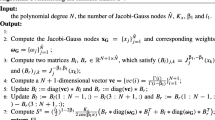Abstract
This paper is devoted to determining a space-dependent source term in an inverse problem of the time-fractional diffusion equation. We use a method based on a finite difference scheme in time and a local discontinuous Galerkin method in space and investigate the numerical stability and convergence of the proposed method. Finally, various numerical examples are used illustrate the effectiveness and accuracy of the method.





Similar content being viewed by others
References
Boyd, S., Vandenbergh, L.: Convex Optimization. Cambridge University Press, Cambridge (2004)
Cheng, J., Nakagawa, J., Yamamoto, M., Yamazaki, T.: Uniqueness in an inverse problem for a one-dimensional fractional diffusion equation. Inverse Probl. 25, 115002 (2009)
Cockburn, B., Shu, C.W.: The local discontinuous Galerkin method for time-dependent convection–diffusion systems. SIAM J. Numer. Anal. 35, 2440–2463 (1998)
Cockburn, B., Shu, C.W.: The Runge–Kutta discontinuous Galerkin method for conservation laws V: multidimensional systems. J. Comput. Phys. 141, 199–224 (1998)
Cockburn, B., Kanschat, G., Perugia, I., Schotzau, D.: Superconvergence of the local discontinuous Galerkin method for elliptic problems on Cartesian grids. SIAM J. Numer. Anal. 39, 264–285 (2001)
Deng, W.H.: Finite element method for the space and time fractional Fokker–Planck equation. SIAM J. Numer. Anal. 47, 204–226 (2008)
Deng, W.H., Hesthaven, J.S.: Local discontinuous Galerkin methods for fractional diffusion equations. Math. Model. Numer. Anal. 47, 1845–1864 (2013)
Deng, W., Hesthaven, J.S.: Local discontinuous Galerkin methods for fractional ordinary differential equations. BIT 55(4), 967–985 (2015)
Geng, F.Z., Lin, Y.Z.: Application of the variational iteration method to inverse heat source problems. Comput. Math. Appl. 58(11–12), 2098–2102 (2009)
Hansen, P.C.: The discrete Picard condition for discrete ill-posed problems. BIT 30, 658–672 (1990)
Hansen, P.C.: Regularization tools: a Matlab package for analysis and solution of discrete ill-posed problems. Numer. Algorithms 6, 1–35 (1994)
Jiang, Y.J., Ma, J.T.: High-order finite element methods for time-fractional partial differential equations. J. Comput. Appl. Math. 235(11), 3285–3290 (2011)
Li, C.Z., Chen, Y.: Numerical approximation of nonlinear fractional differential equations with subdiffusion and superdiffusion. Comput. Math. Appl. 62, 855–875 (2011)
Lin, Y.M., Xu, C.J.: Finite difference/spectral approximations for the time-fractional diffusion equation. J. Comput. Phys. 225, 1533–1552 (2007)
Liu, J.J., Yamamoto, M.: A backward problem for the time-fractional diffusion equation. Appl. Anal. 89, 1769–1788 (2010)
Murio, D.A.: Stable numerical solution of a fractional-diffusion inverse heat conduction problem. Comput. Math. Appl. 53, 1492–1501 (2007)
Murio, D.A.: Time fractional IHCP with Caputo fractional derivatives. Comput. Math. Appl. 56, 2371–2381 (2008)
Murio, D.A.: Stable numerical evaluation of Grünwald–Letnikov fractional derivatives applied to a fractional IHCP. Inverse Probl. Sci. Eng. 17, 229–243 (2009)
Qian, Z.: Optimal modified method for a fractional-diffusion inverse heat conduction problem. Inverse Probl. Sci. Eng. 18, 521–533 (2010)
Riviére, B.: Discontinuous Galerkin Methods for Solving Elliptic and Parabolic Equations: Theory and Implementation. Rice University, Houston (2008)
Rundell, W., Xu, X., Zuo, L.H.: The determination of an unknown boundary condition in a fractional diffusion equation. Appl. Anal. 92, 1–16 (2012)
Sakamoto, K., Yamamoto, M.: Initial value/boundary value problems for fractional diffusion-wave equations and applications to some inverse problems. J. Math. Anal. Appl. 382(1), 426–447 (2011)
Shidfar, A., Babaei, A., Molabahrami, A.: Solving the inverse problem of identifying an unknown source term in a parabolic equation. Comput. Math. Appl. 60(5), 1209–1213 (2010)
Tuan, V.K.: Inverse problem for fractional diffusion equation. Fract. Calc. Appl. Anal. 14, 31–55 (2011)
Wei, H., Chen, W., Sun, H.G., Li, X.C.: A coupled method for inverse source problem of spatial fractional anomalous diffusion equations. Inverse Probl. Sci. Eng. 18, 945–956 (2010)
Wang, J.G., Zhou, Y.B., Wei, T.: Two regularization methods to identify a space-dependent source for the time-fractional diffusion equation. Appl. Numer. Math. 68, 39–57 (2013)
Wei, T., Wang, J.G.: A modified quasi-boundary value method for an inverse source problem of the time-fractional diffusion equation. Appl. Numer. Math. 78, 95–111 (2014)
Wei, L.L., Zhang, X.D., He, Y.N.: Analysis of a local discontinuous Galerkin method for time-fractional advection–diffusion equations. Int. J. Numer. Methods Heat Fluid Flow 23, 634–648 (2013)
Wei, T., Zhang, Z.Q.: Reconstruction of a time-dependent source term in a time-fractional diffusion equation. Eng. Anal. Bound. Elem. 37, 23–31 (2013)
Wei, T., Zhang, Z.Q.: Stable numerical solution to a Cauchy problem for a time fractional diffusion equation. Eng. Anal. Bound. Elem. 40, 128–137 (2014)
Xu, Q., Hesthaven, J.S.: Discontinuous Galerkin method for fractional convection–diffusion equations. SIAM J. Numer. Anal. 52(1), 405–423 (2014)
Xu, Y., Shu, C.W.: Local discontinuous Galerkin method for the Camassa–Holm equation. SIAM J. Numer. Anal. 46, 1998–2021 (2008)
Zhang, Z.Q., Wei, T.: Identifying an unknown source in time-fractional diffusion equation by a truncation method. Appl. Math. Comput. 219, 5972–5983 (2013)
Zheng, G.H., Wei, T.: Spectral regularization method for a Cauchy problem of the time fractional advection–dispersion equation. J. Comput. Appl. Math. 233, 2631–2640 (2010)
Zheng, G.H., Wei, T.: A new regularization method for Cauchy problem of the fractional diffusion equation. Adv. Comput. Math. 36, 377–398 (2012)
Acknowledgements
Mrs. S. Yeganeh wishes to express her appreciation for the warm hospitality she enjoyed during a visit to EPFL where part of this work was done. The authors also thank the anonymous reviewers for their thorough feedback which helped improve the paper.
Author information
Authors and Affiliations
Corresponding author
Additional information
Communicated by Lars Eldén.
Appendix
Appendix
We seek to explain why our proposed method need not regularization method. Consider the time-fractional diffusion equation (1.1), with \(a(x)=1\) and \(c(x)=0\) (as we consider in Examples 4.1 and 4.3–4.5). Let us decompose the domain of the problem into cells of equal length h and choose for local basis functions of \({\mathbb {P}}^1(I_j)\) the monomial basis functions [20]. Solving (3.4), we have
therefore \({\bar{K}}_{12}K_{22}^{-1}{\bar{K}}_{21}K_{22}^{-1}=(0)_{2N\times 2N}\), \(K_m=I\) and
\(A_M\) has a complex structure and we are not able to find a closed form for it. In Table 6, we report \(\parallel A_M^{-1}\parallel _2\) for different values of \(\alpha \). Obviously \(\parallel A_M^{-1}\parallel _2\) has a reasonable size and therefore in Examples 4.1 and 4.3–4.5 numerical solutions are not sensitive with respect to the perturbation in the initial data.
Picard plot for Example 4.2 (\(\alpha =0.1\))
Picard plot for Example 4.2 (\(\alpha =0.6\))
Picard plot for Example 4.2 (\(\alpha =0.95\))
In Table 7, we show \(L^2\)-norm of matrices G, \(A_M^{-1}G\) and \(A_M^{-1}\) for Example 4.2. Obviously, \(\parallel A_M^{-1} G^\delta \parallel _2\) is small and \(\parallel A_M^{-1} \parallel _2\) has a reasonable size. Therefore numerical solutions are not sensitive with respect to the perturbation in the initial data.
Therefore, we need not any regularization method.
The sequel of this appendix is devoted to investigating the discrete Picard condition [10] in order to show that our proposed method need not any regularization. Here we just investigate Example 4.2. Similar results obtain for Examples 4.3–4.5. We use the MATLAB codes developed by Hansen [11] to prepare Picard plots for both the unperturbed and the perturbed data with various noise levels \(\varepsilon =0.1, 1, 10\%\) which presented in Figs. 6, 7 and 8 for \(\alpha =0.1, 0.6, 0.95\), respectively. In all cases, the Fourier coefficients \(V_i^TR\) decay to zero faster than the \(\sigma _i\). Here, \((\sigma _i,V_i)\)’s are the pair of singular values and corresponding (left) singular vectors of matrix \(A_M\) and R is the right-hand side of the linear system which will be solved, i.e. \(A_MF=R:=K_M G-\beta G_1+\beta {\bar{K}}_{12} K_{22}^{-1} G_2\). Therefore, according to the discrete Picard condition, our method need not any regularization.
Rights and permissions
About this article
Cite this article
Yeganeh, S., Mokhtari, R. & Hesthaven, J.S. Space-dependent source determination in a time-fractional diffusion equation using a local discontinuous Galerkin method. Bit Numer Math 57, 685–707 (2017). https://doi.org/10.1007/s10543-017-0648-y
Received:
Accepted:
Published:
Issue Date:
DOI: https://doi.org/10.1007/s10543-017-0648-y







